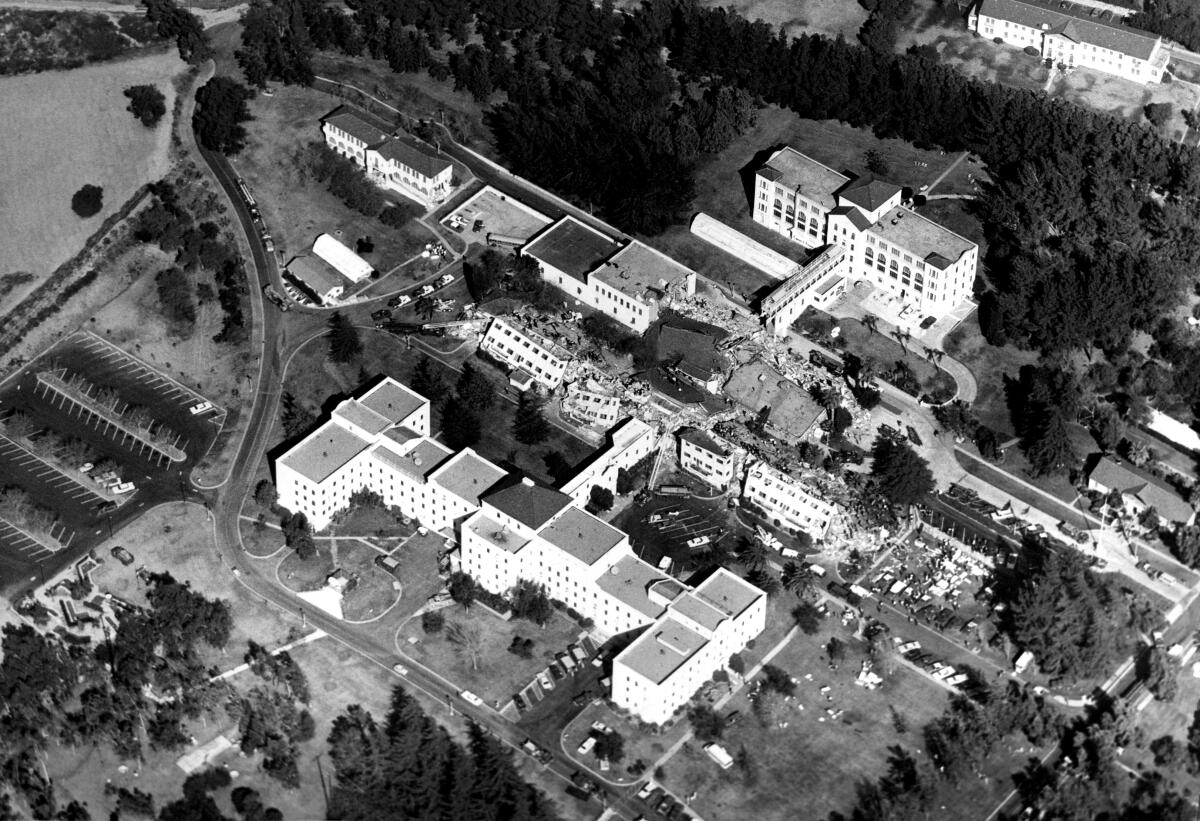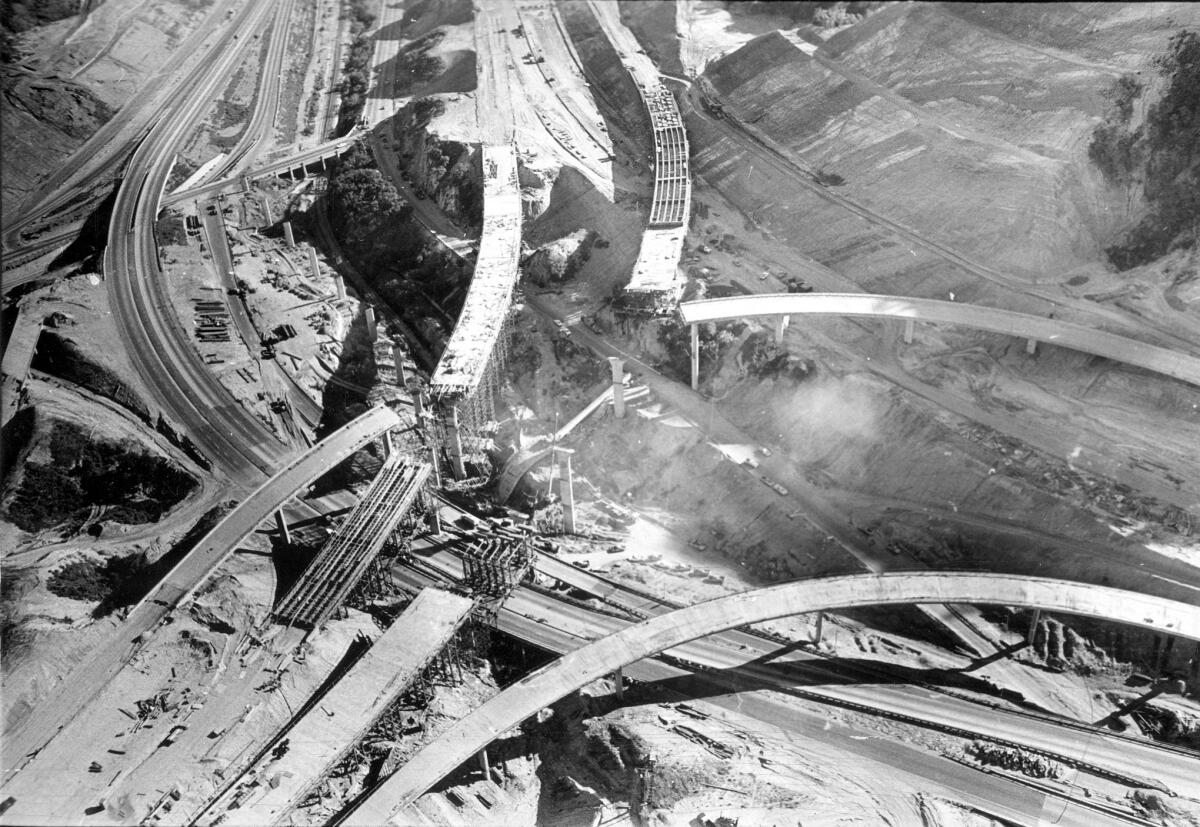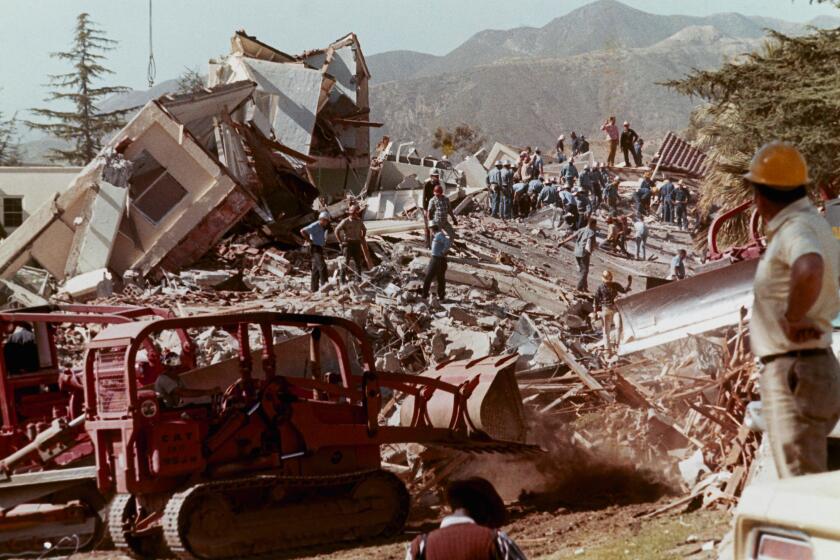Column: We shake, we rattle, we roll — life in a state that’s one giant fault zone

- Share via
It was a Tuesday exactly half a century ago, just after 6 a.m., and most of Los Angeles was dozing. The wake-up call lasted 12 seconds, registered 6.6 on the Richter scale, buckled buildings and killed 64 people.
Those who recall what is known as the Sylmar or San Fernando earthquake of 1971 describe the experience as if the ground is still shaking, with specific markers seared into their memories.
“Lots of broken glass in the kitchen, and the five-gallon Sparkletts bottle exploded on impact,” says Howard Cohen, who was 8 at the time and living in Lakeview Terrace. He recalls his bed moving during the initial quake and the aftershocks in the bedroom he shared with his grandmother.
In Altadena, a young assistant professor of civil engineering at Caltech was awakened by the rattling of windows and the creaking of the old house he lived in. Paul Jennings’ first concern was his children’s safety.
“I got up to make sure the kids didn’t come running out of their bedrooms” and into harm’s way, said Jennings, now 85 and retired. The very next day, he joined a team of experts who toured damaged hospitals to study the destructive force of the deadly quake.
In West Los Angeles, 19-year-old UCLA student Jerry Treiman, who had just switched majors from physics to geology, got a crash course — so to speak — on the vulnerability of all Californians.
“I jumped out of bed, waited a moment, and it was still shaking,” said Treiman, who would go on to work as a state engineering geologist and earthquake risk and preparedness specialist. “I thought this could be the Big One, and the ceiling plaster might start falling. So I jumped back in bed and put a pillow over my head.”
The magnitude 6.6 Sylmar earthquake shook Southern California on Feb. 9, 1971, causing significant damage and 64 deaths. What few realized at the time was how close it came to being far more catastrophic.
Every Californian lives with the threat of it happening all over again, as it did in the 1994 Northridge earthquake. And we can’t forget that both Sylmar and Northridge were moderate quakes in a state that has had far more serious seismic events through time — and will have them again.
But the danger, though ever-present, is easily pushed off our radar screens, maybe because we’ve got other things to worry about. We know we’re in the midst of a pandemic with a long fight ahead of us. We worry about fires and the state getting hotter, but at least we know roughly when we’ll bake. We never know when we’ll shake.

Earthquakes hit like sucker punches. No heads-up.
Lucy Jones, L.A.’s earthquake lady, knows as well as anyone how hard it is to get people focused on preparing for an unwanted visitor with no scheduled arrival time.
“We’ve evolved to deal with our most immediate threat,” she said.
At the moment, that happens to be COVID-19, which, as Jones pointed out, is “killing a lot more people than any earthquake could.”
It was Jones who cured me of earthquake denial four years ago on a tour of the San Andreas fault, when she delivered an earful to dozens of local officials who have not upgraded building codes, earthquake preparation and seismic safety standards.
Under the windmills near Palm Springs, Jones and her geologist colleagues stood me next to my colleague Ron Lin, with him on the tectonic plate that’s heading to Mexico and me on the plate that’s grinding toward Alaska. I was led north for ten seconds, putting 30 feet between me and Lin. That’s what the Big One will do, and I can’t get that image out of my head.
I’ve seen the fence at Point Reyes that was split by the San Andreas during the 1906 San Francisco quake, with a 20-foot separation where the picket line shifted, but it didn’t register the same way as my personal lesson in catastrophic possibility.
The experts explained that Interstate 10 might be unnavigable, and that communication, power, gas and water arteries that cross the San Andreas in the Cajon Pass could be damaged, crippling basic services for weeks or months and clobbering the economy.
I knew my house was bolted, but Jones explained that across Los Angeles, seismic safety and building design standards have been in flux for decades, and there is little uniformity. We have a damaging earthquake, like the Long Beach monster in 1933 that killed more than 100 people, and we immediately establish new standards. And then go back to sleep.
The Times recalls how the quake that rumbled through L.A. on Feb. 9, 1971, woke California up to a largely unfamiliar danger.
It turned out that my house was bolted to decades-old standards, and that the cripple walls — the stud frame under the house — were not braced. So I upgraded, but Jones estimated that as many as half or more of the homes in Greater L.A. may need such upgrades.
The Sylmar/San Fernando quake was a wake-up call in more ways than one. Geologists and engineers were surprised not just by the degree of shaking but by the narrowness of our escape from far greater disaster. The Lower Van Norman Dam nearly ruptured, and had it done so, an estimated 80,000 downstream residents would have been submerged. Dam construction standards the world over were upgraded as a result.
Extensive damage to the Olive View and Veterans Administration hospitals, as well as hundreds of other buildings, led to the rewriting of building engineering standards, particularly with regard to concrete buildings. But we would soon learn that even more was needed. The Northridge quake, 23 years later, delivered stark evidence that buildings with “soft stories,” like the ubiquitous apartment and office buildings where we park our cars between stilts that support upper floors, were as crushable as cracker boxes, and that steel-frame buildings were not as invulnerable as previously thought.
State Assemblyman Adrin Nazarian (D-Van Nuys) recalls hovering near a doorway with his parents in the moments after the Northridge quake, which tossed items from shelves and damaged the homes of nearby relatives.
“Every time we’d venture away to pick up a piece of broken glass, another rumble would come and we’d go back to the same doorway entrance,” said Nazarian, who is marking the 50th anniversary of the Sylmar/San Fernando quake by introducing the Seismic Functional Recovery Act, which calls for new buildings to meet higher standards.
State law, as he pointed out, requires building design that protects lives. His bill would require new buildings to better withstand earthquake damage and not be rendered unusable, thereby avoiding loss of jobs and other economic impacts.
Largely because of the lessons of Sylmar and Northridge, California has made great strides in reducing earthquake risk, and the city of Los Angeles in particular has aggressively moved to upgrade poorly designed buildings.
But we’re a long way from where we ought to be on building safety and the protection of power, water and communication lines, many of which cross the San Andreas on their way into Los Angeles. Those are expensive fixes, and as Nazarian said, it’s difficult to convince policymakers or voters that billions should be spent on earthquake readiness when crises like housing and healthcare are in front of us here and now.
All the more reason for individuals to do what they can on their own.
California is a masterpiece of natural beauty in part because much of it was sculpted by seismic forces, and living here means accepting risk as part of the bargain. We can’t prevent earthquakes, but next time you look up in awe at the San Gabes or Santa Monica mountains, let it be a reminder that each of us can be better prepared for the inevitable.
Secure anything that might come tumbling down. Bolt and brace your house. Know how to shut off gas lines that could spark a fire. Put together food and water supplies and medical kits. Keep flashlights handy with backup batteries. Anticipate that cellphones and Wi-Fi might be temporarily lost, that gas pumps might be closed, that grocery stores might not be able to process credit card purchases.
The benefits of living in California are many.
The cost can arrive unexpectedly, as it did just after 6 a.m., 50 years ago today.
More to Read
Sign up for Essential California
The most important California stories and recommendations in your inbox every morning.
You may occasionally receive promotional content from the Los Angeles Times.












